air RENAULT TWINGO 2009 2.G Chasiss Workshop Manual
[x] Cancel search | Manufacturer: RENAULT, Model Year: 2009, Model line: TWINGO, Model: RENAULT TWINGO 2009 2.GPages: 281
Page 1 of 281
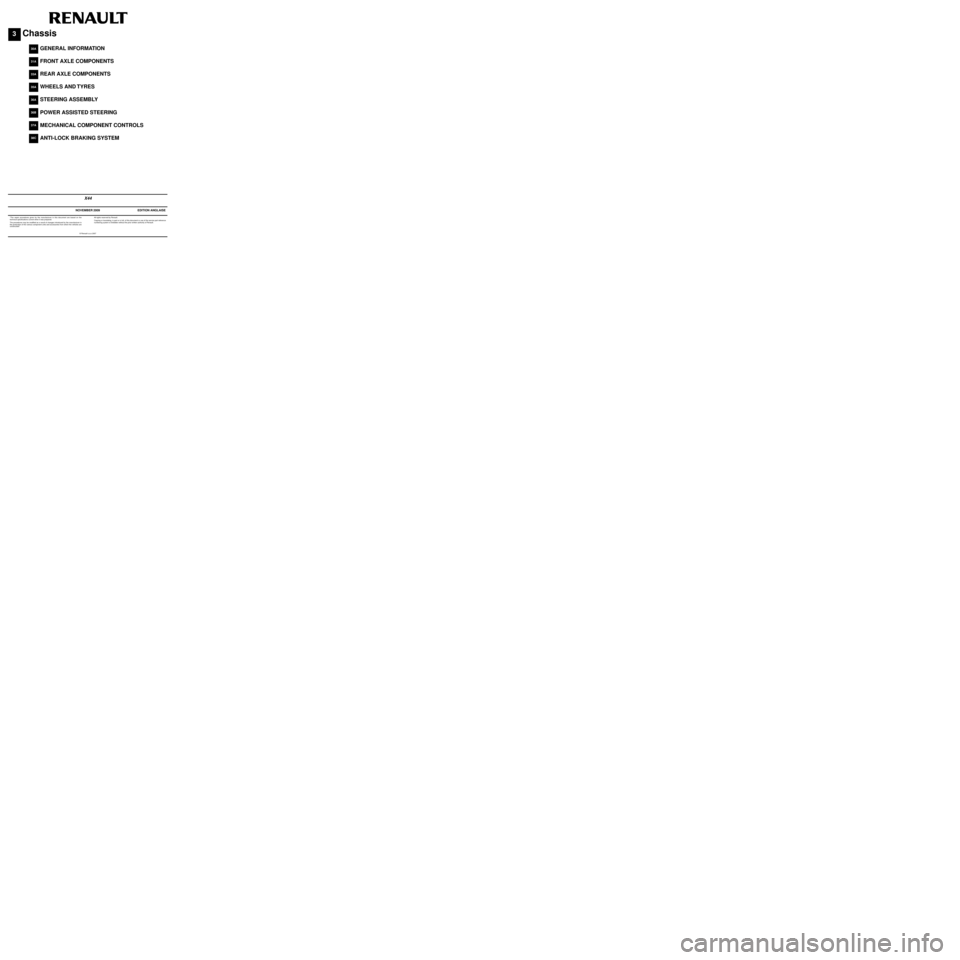
© Renault s.a.s 2007 "The repair procedures given by the manufacturer in this document are based on the
technical specifications current when it was prepared.
The procedures may be modified as a result of changes introduced by the manufacturer in
the production of the various component units and accessories from which the vehicles are
constructed".All rights reserved by Renault.
Copying or translating, in part or in full, of this document or use of the service part reference
numbering system is forbidden without the prior written authority of Renault.
NOVEMBER 2009 EDITION ANGLAISE
X44
3Chassis
30AGENERAL INFORMATION
31AFRONT AXLE COMPONENTS
33AREAR AXLE COMPONENTS
35AWHEELS AND TYRES
36ASTEERING ASSEMBLY
36BPOWER ASSISTED STEERING
37AMECHANICAL COMPONENT CONTROLS
38CANTI-LOCK BRAKING SYSTEM
Page 2 of 281
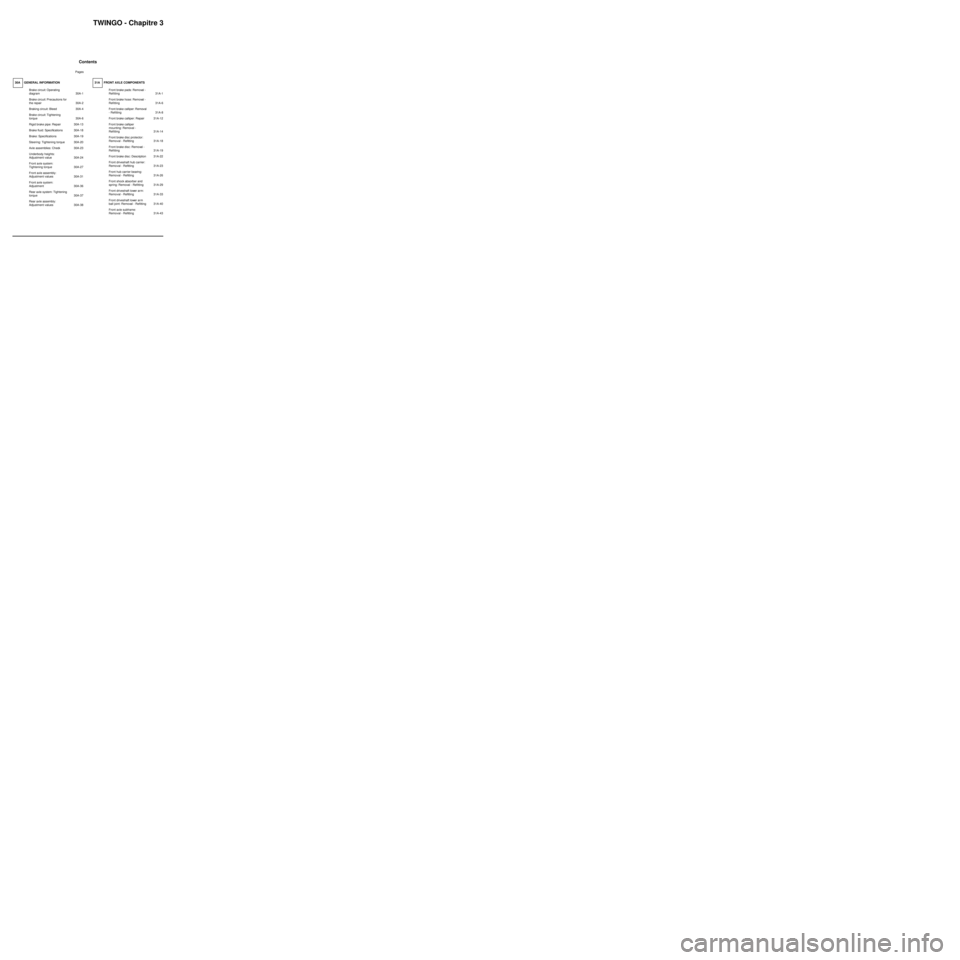
TWINGO - Chapitre 3
Contents
Pages
TWINGO - Chapitre 3ContentsPages
30A GENERAL INFORMATION
Brake circuit: Operating
diagram 30A-1
Brake circuit: Precautions for
the repair 30A-2
Braking circuit: Bleed 30A-4
Brake circuit: Tightening
torque 30A-6
Rigid brake pipe: Repair 30A-13
Brake fluid: Specifications 30A-18
Brake: Specifications 30A-19
Steering: Tightening torque 30A-20
Axle assemblies: Check 30A-23
Underbody heights:
Adjustment value 30A-24
Front axle system:
Tightening torque 30A-27
Front axle assembly:
Adjustment values 30A-31
Front axle system:
Adjustment 30A-36
Rear axle system: Tightening
torque 30A-37
Rear axle assembly:
Adjustment values 30A-3831A FRONT AXLE COMPONENTS
Front brake pads: Removal -
Refitting 31A-1
Front brake hose: Removal -
Refitting 31A-6
Front brake calliper: Removal
- Refitting 31A-8
Front brake calliper: Repair 31A-12
Front brake calliper
mounting: Removal -
Refitting 31A-14
Front brake disc protector:
Removal - Refitting 31A-18
Front brake disc: Removal -
Refitting 31A-19
Front brake disc: Description 31A-22
Front driveshaft hub carrier:
Removal - Refitting 31A-23
Front hub carrier bearing:
Removal - Refitting 31A-26
Front shock absorber and
spring: Removal - Refitting 31A-29
Front driveshaft lower arm:
Removal - Refitting 31A-33
Front driveshaft lower arm
ball joint: Removal - Refitting 31A-40
Front axle subframe:
Removal - Refitting 31A-43
Page 6 of 281
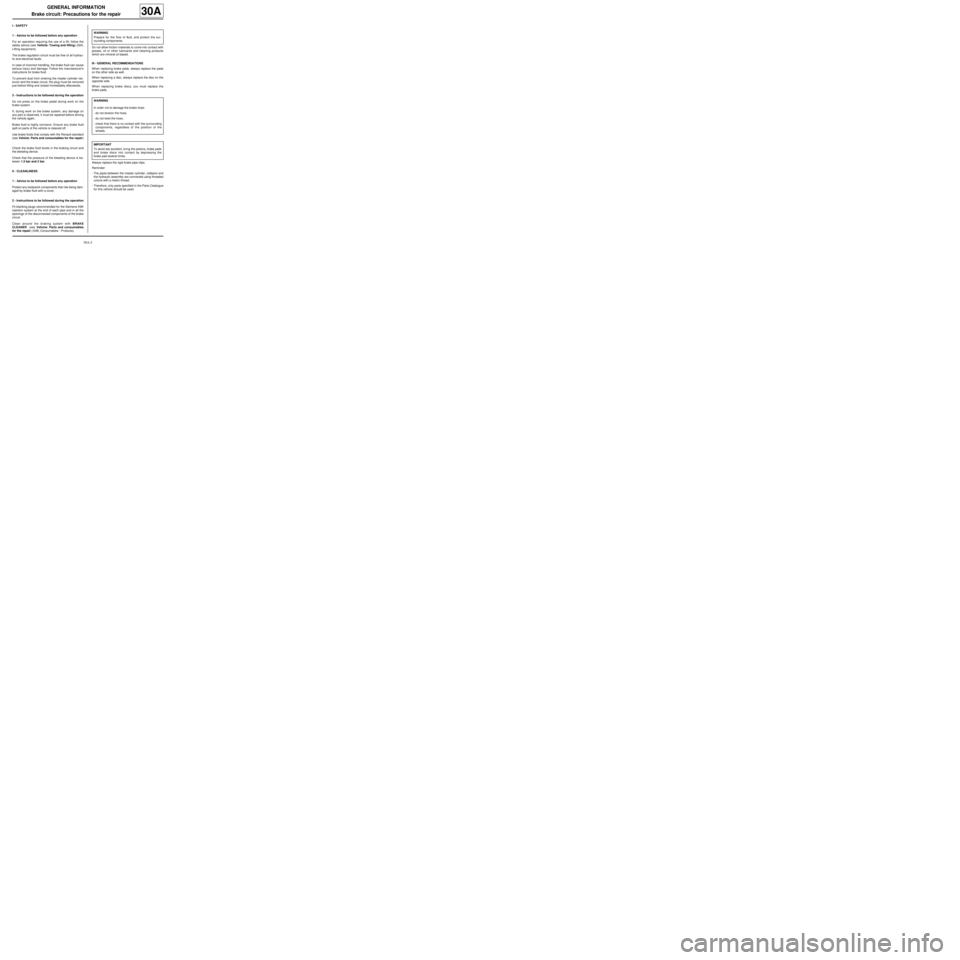
30A-2
GENERAL INFORMATION
Brake circuit: Precautions for the repair
30A
I - SAFETY
1 - Advice to be followed before any operation
For an operation requiring the use of a lift, follow the
safety advice (see Vehicle: Towing and lifting) (02A,
Lifting equipment).
The brake regulation circuit must be free of all hydrau-
lic and electrical faults.
In case of incorrect handling, the brake fluid can cause
serious injury and damage. Follow the manufacturer's
instructions for brake fluid.
To prevent dust from entering the master cylinder res-
ervoir and the brake circuit, the plug must be removed
just before filling and closed immediately afterwards,
2 - Instructions to be followed during the operation
Do not press on the brake pedal during work on the
brake system.
If, during work on the brake system, any damage on
any part is observed, it must be repaired before driving
the vehicle again.
Brake fluid is highly corrosive. Ensure any brake fluid
spilt on parts of the vehicle is cleaned off.
Use brake fluids that comply with the Renault standard
(see Vehicle: Parts and consumables for the repair)
.
Check the brake fluid levels in the braking circuit and
the bleeding device.
Check that the pressure of the bleeding device is be-
tween 1.5 bar and 2 bar.
II - CLEANLINESS
1 - Advice to be followed before any operation
Protect any bodywork components that risk being dam-
aged by brake fluid with a cover.
2 - Instructions to be followed during the operation
Fit blanking plugs recommended for the Siemens K9K
injection system at the end of each pipe and in all the
openings of the disconnected components of the brake
circuit.
Clean around the braking system with BRAKE
CLEANER (see Vehicle: Parts and consumables
for the repair) (04B, Consumables - Products).Do not allow friction materials to come into contact with
grease, oil or other lubricants and cleaning products
which are mineral oil based.
III - GENERAL RECOMMENDATIONS
When replacing brake pads, always replace the pads
on the other side as well.
When replacing a disc, always replace the disc on the
opposite side.
When replacing brake discs, you must replace the
brake pads.
Always replace the rigid brake pipe clips.
Reminder:
-The pipes between the master cylinder, callipers and
the hydraulic assembly are connected using threaded
unions with a metric thread.
-Therefore, only parts specified in the Parts Catalogue
for this vehicle should be used. WARNING
Prepare for the flow of fluid, and protect the sur-
rounding components.
WARNING
In order not to damage the brake hose:
-do not tension the hose,
-do not twist the hose,
-check that there is no contact with the surrounding
components, regardless of the position of the
wheels.
IMPORTANT
To avoid any accident, br ing the pistons, brake pads
and brake discs into contact by depressing the
brake pad several times.
Page 7 of 281
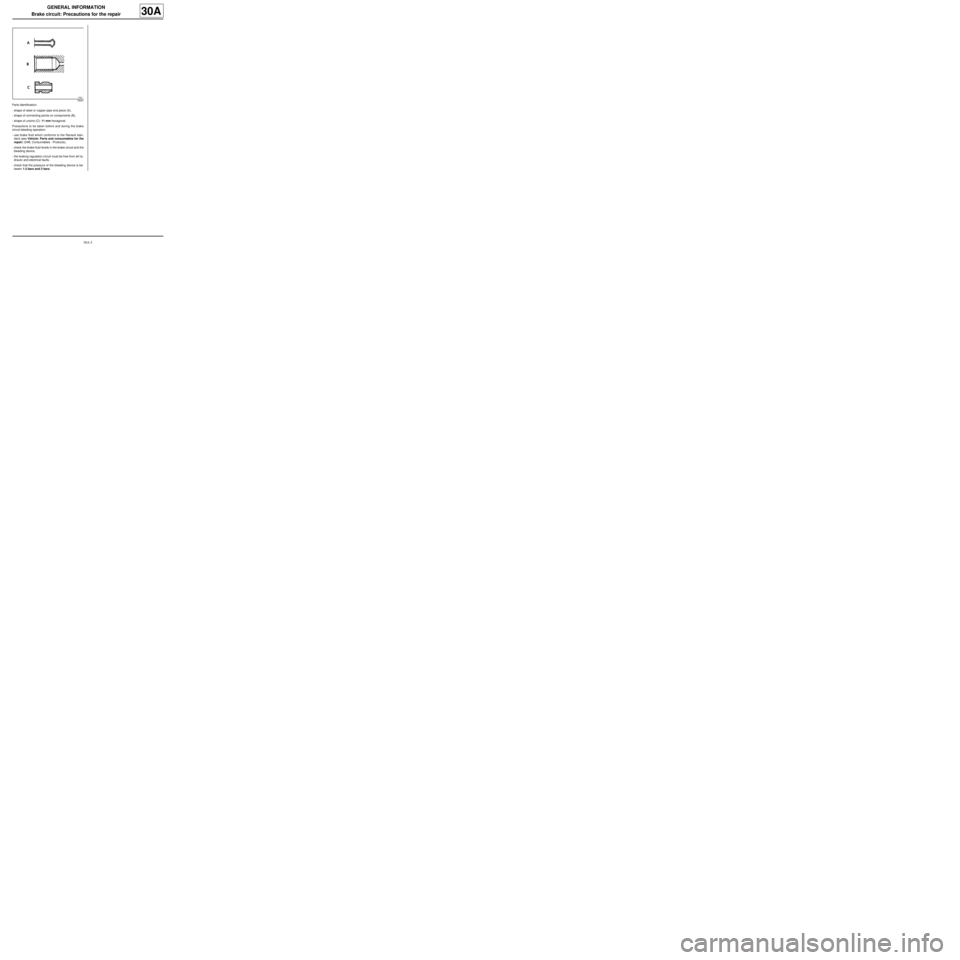
30A-3
GENERAL INFORMATION
Brake circuit: Precautions for the repair
30A
Parts identification:
-shape of steel or copper pipe end piece (A),
-shape of connecting points on components (B),
-shape of unions (C): 11 mm hexagonal.
Precautions to be taken before and during the brake
circuit bleeding operation:
-use brake fluid which conforms to the Renault stan-
dard (see Vehicle: Parts and consumables for the
repair) (04B, Consumables - Products),
-check the brake fluid levels in the brake circuit and the
bleeding device,
-the braking regulation circuit must be free from all hy-
draulic and electrical faults,
-check that the pressure of the bleeding device is be-
tween 1.5 bars and 2 bars.
78491
Page 8 of 281
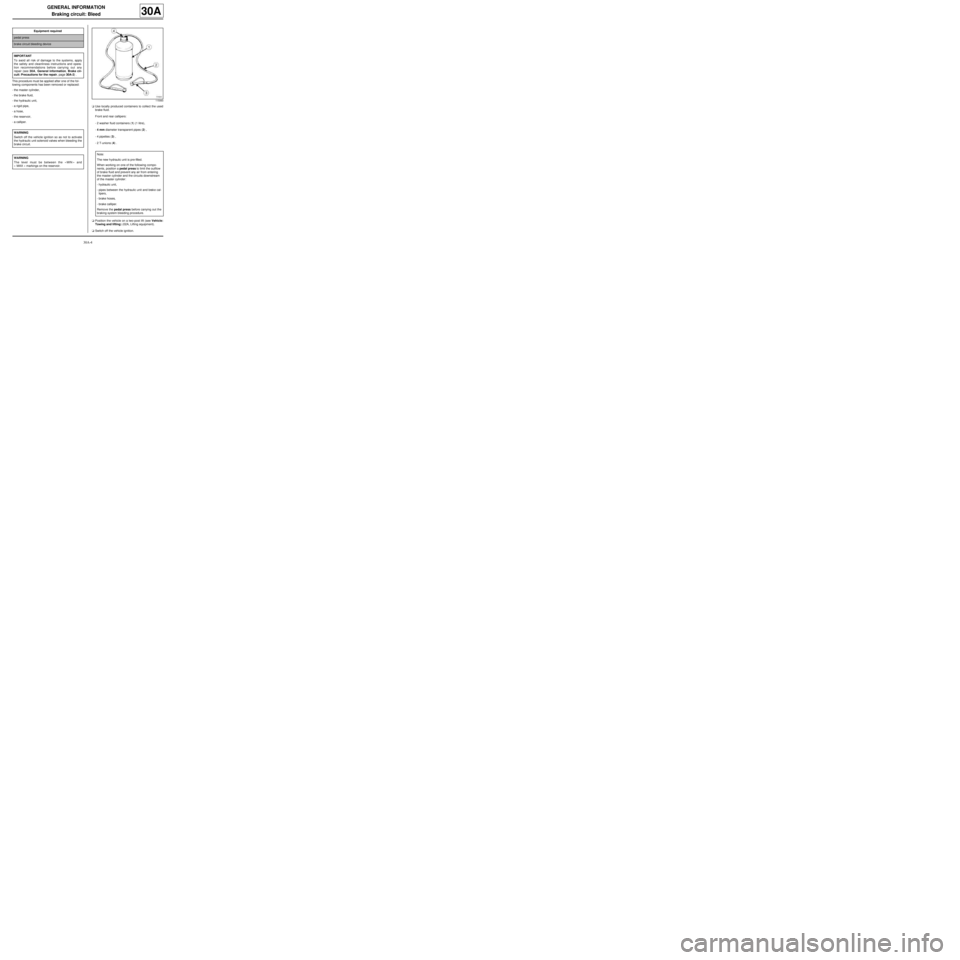
30A-4
GENERAL INFORMATION
Braking circuit: Bleed
30A
This procedure must be applied after one of the fol-
lowing components has been removed or replaced:
-the master cylinder,
-the brake fluid,
-the hydraulic unit,
-a rigid pipe,
-a hose,
-the reservoir,
-a calliper.aUse locally produced containers to collect the used
brake fluid.
Front and rear callipers:
-2 washer fluid containers (1) (1 litre),
-4 mm diameter transparent pipes (2) ,
-4 pipettes (3) ,
-2 T-unions (4) .
aPosition the vehicle on a two-post lift (see Vehicle:
Towing and lifting) (02A, Lifting equipment).
aSwitch off the vehicle ignition. Equipment required
pedal press
brake circuit bleeding device
IMPORTANT
To avoid all risk of damage to the systems, apply
the safety and cleanliness instructions and opera-
tion recommendations before carrying out any
repair (see 30A, General information, Brake cir-
cuit: Precautions for the repair, page 30A-2) .
WARNING
Switch off the vehicle ignition so as not to activate
the hydraulic unit solenoid valves when bleeding the
brake circuit.
WARNING
The level must be between the « MIN » and
« MAX » markings on the reservoir.
115993
Note:
The new hydraulic unit is pre-filled.
When working on one of the following compo-
nents , position a pedal press to limit the outflow
of brake fluid and prevent any air from entering
the master cylinder and the circuits downstream
of the master cylinder:
-hydraulic unit,
-pipes between the hydraulic unit and brake cal-
lipers,
-brake hoses,
-brake calliper.
Remove the pedal press before carrying out the
braking system bleeding procedure.
Page 9 of 281
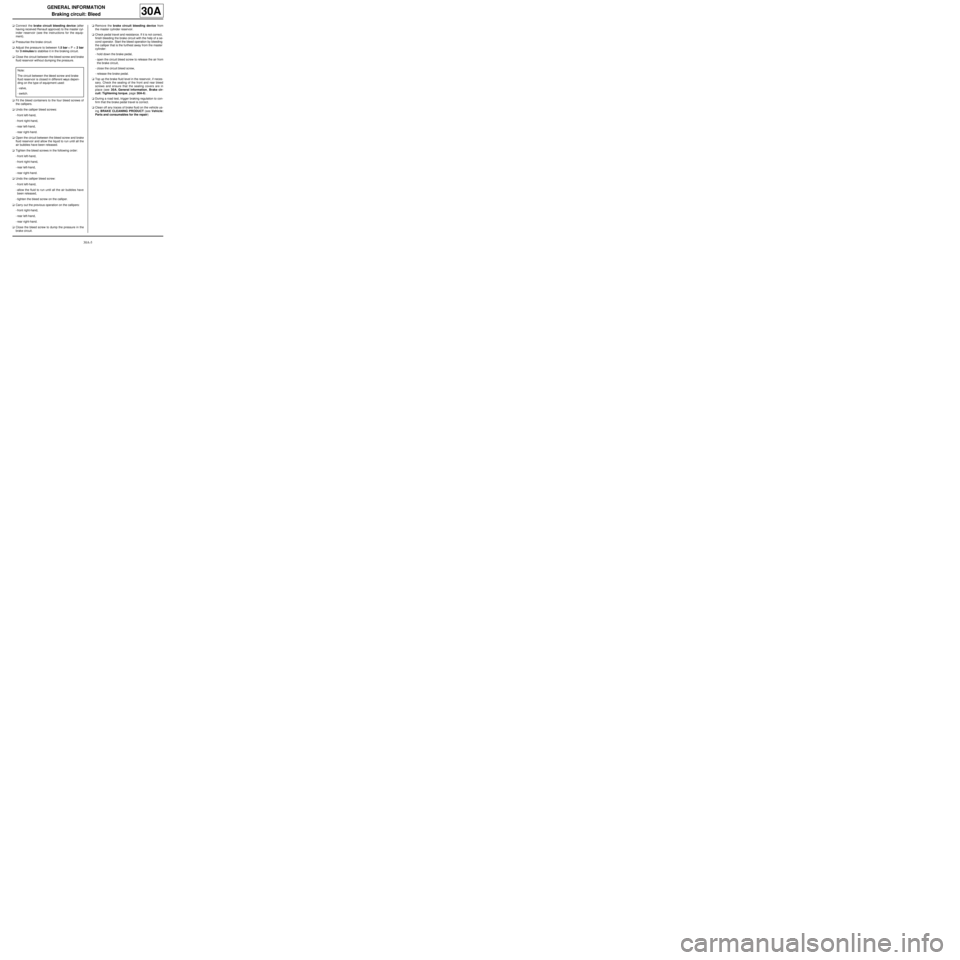
30A-5
GENERAL INFORMATION
Braking circuit: Bleed
30A
aConnect the brake circuit bleeding device (after
having received Renault approval) to the master cyl-
inder reservoir (see the instructions for the equip-
ment).
aPressurise the brake circuit.
aAdjust the pressure to between 1.5 bar < P < 2 bar
for 3 minutes to stabilise it in the braking circuit.
aClose the circuit between the bleed screw and brake
fluid reservoir without dumping the pressure.
aFit the bleed containers to the four bleed screws of
the callipers.
aUndo the calliper bleed screws:
-front left-hand,
-front right-hand,
-rear left-hand,
-rear right-hand.
aOpen the circuit between the bleed screw and brake
fluid reservoir and allow the liquid to run until all the
air bubbles have been released.
aTighten the bleed screws in the following order:
-front left-hand,
-front right-hand,
-rear left-hand,
-rear right-hand.
aUndo the calliper bleed screw:
-front left-hand,
-allow the fluid to run until all the air bubbles have
been released,
-tighten the bleed screw on the calliper.
aCarry out the previous operation on the callipers:
-front right-hand,
-rear left-hand,
-rear right-hand.
aClose the bleed screw to dump the pressure in the
brake circuit.aRemove the brake circuit bleeding device from
the master cylinder reservoir.
aCheck pedal travel and resistance. If it is not correct,
finish bleeding the brake circuit with the help of a se-
cond operator. Start the bleed operation by bleeding
the calliper that is the furthest away from the master
cylinder:
-hold down the brake pedal,
-open the circuit bleed screw to release the air from
the brake circuit,
-close the circuit bleed screw,
-release the brake pedal.
aTop up the brake fluid level in the reservoir, if neces-
sary. Check the sealing of the front and rear bleed
screws and ensure that the sealing covers are in
place (see 30A, General information, Brake cir-
cuit: Tightening torque, page 30A-6) .
aDuring a road test, trigger braking regulation to con-
firm that the brake pedal travel is correct.
aClean off any traces of brake fluid on the vehicle us-
ing BRAKE CLEANING PRODUCT (see Vehicle:
Parts and consumables for the repair) Note:
The circuit between the bleed screw and brake
fluid reservoir is closed in different ways depen-
ding on the type of equipment used:
-valve,
-switch.
Page 17 of 281
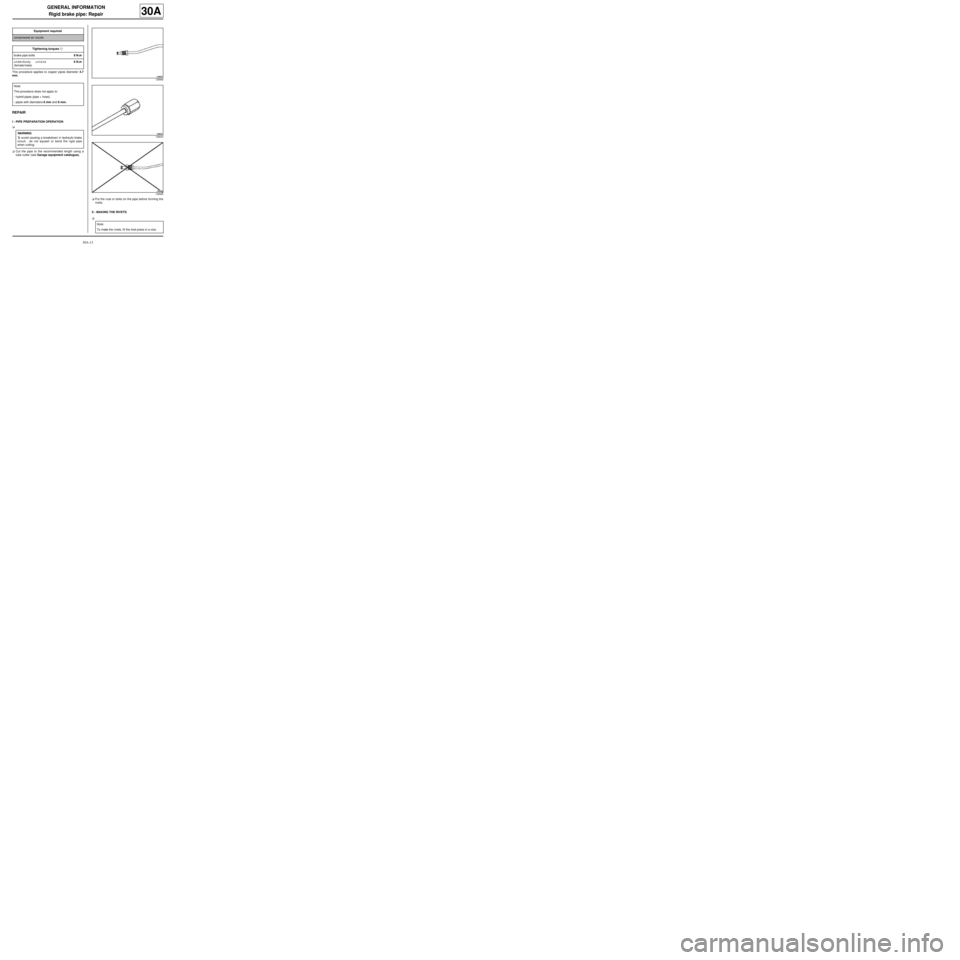
30A-13
GENERAL INFORMATION
Rigid brake pipe: Repair
30A
This procedure applies to copper pipes diameter 4.7
mm.
REPAIR
I - PIPE PREPARATION OPERATION
a
aCut the pipe to the recommended length using a
tube cutter (see Garage equipment catalogue).
aPut the nuts or bolts on the pipe before forming the
rivets.
II - MAKING THE RIVETS
a Equipment required
compressed air nozzle
Tightening torquesm
brake pipe bolts8 N.m
underbody unions
(female/male)6 N.m
Note:
This procedure does not apply to:
-hybrid pipes (pipe + hose),
-pipes with diameters 6 mm and 8 mm.
WARNING
To avoid causing a breakdown in hydraulic brake
circuit , do not squash or bend the rigid pipe
when cutting.
128666
128643
128665
Note:
To make the r ivets, fit the rivet press in a vice.
Page 18 of 281
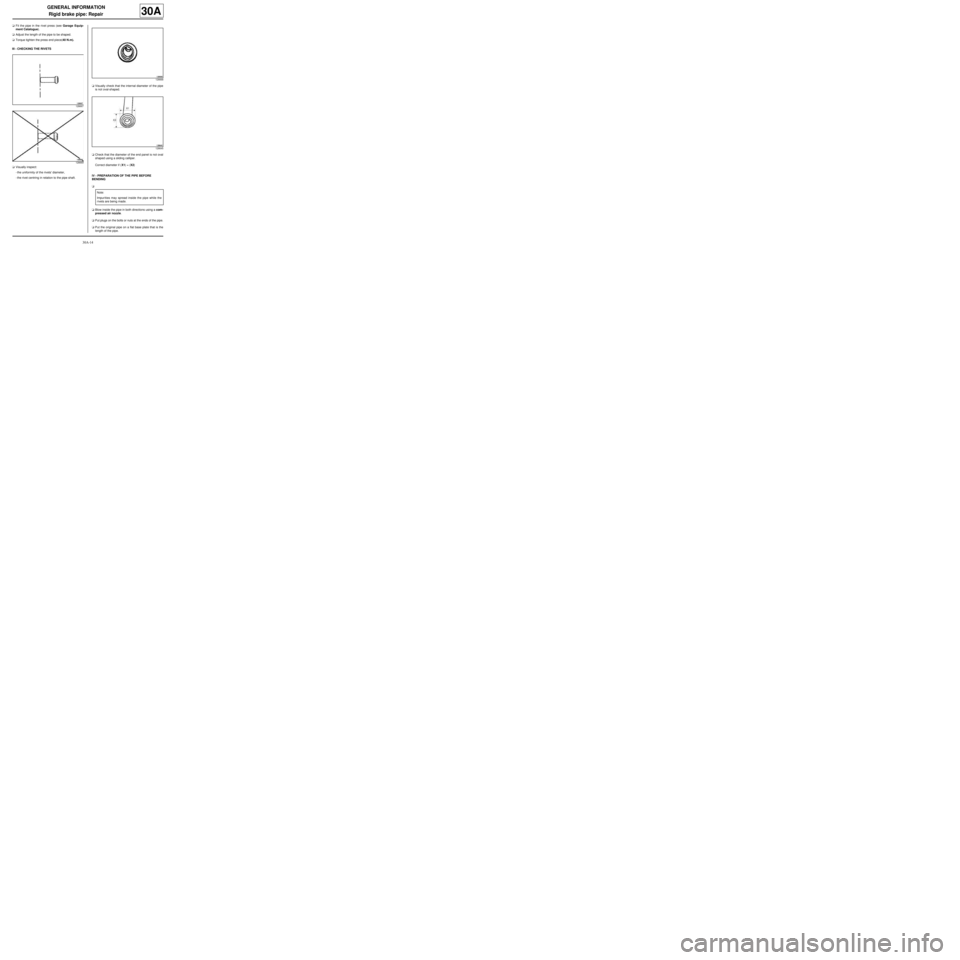
30A-14
GENERAL INFORMATION
Rigid brake pipe: Repair
30A
aFit the pipe in the rivet press (see Garage Equip-
ment Catalogue).
aAdjust the length of the pipe to be shaped.
aTorque tighten the press end piece(40 N.m).
III - CHECKING THE RIVETS
aVisually inspect:
-the uniformity of the rivets' diameter,
-the rivet centring in relation to the pipe shaft.aVisually check that the internal diameter of the pipe
is not oval-shaped.
aCheck that the diameter of the end panel is not oval
shaped using a sliding calliper.
Correct diameter if (X1) = (X2)
IV - PREPARATION OF THE PIPE BEFORE
BENDING
a
aBlow inside the pipe in both directions using a com-
pressed air nozzle.
aPut plugs on the bolts or nuts at the ends of the pipe.
aPut the original pipe on a flat base plate that is the
length of the pipe.
128667
128669
128668
128645
Note:
Impurities may spread inside the pipe while the
rivets are being made.
Page 19 of 281
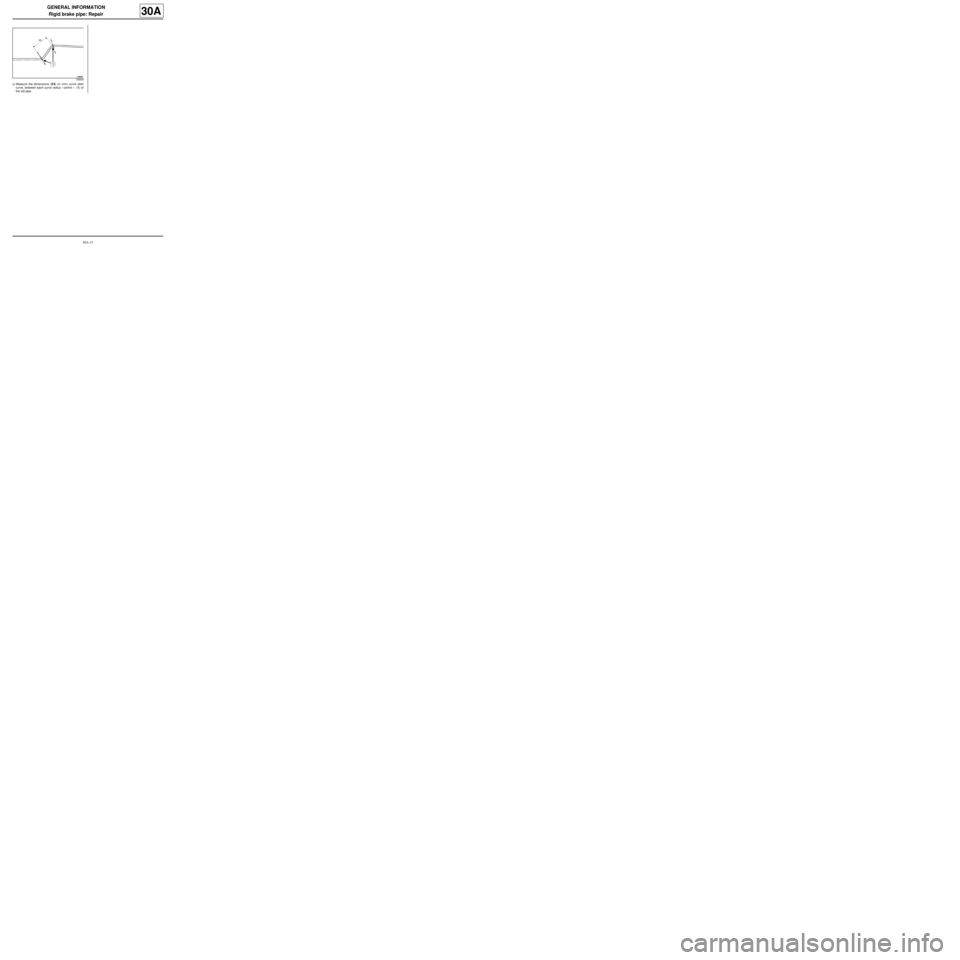
30A-15
GENERAL INFORMATION
Rigid brake pipe: Repair
30A
aMeasure the dimensions (X3) (in mm) curve after
curve, between each curve radius « centre » (1) of
the old pipe.
128659
Page 20 of 281
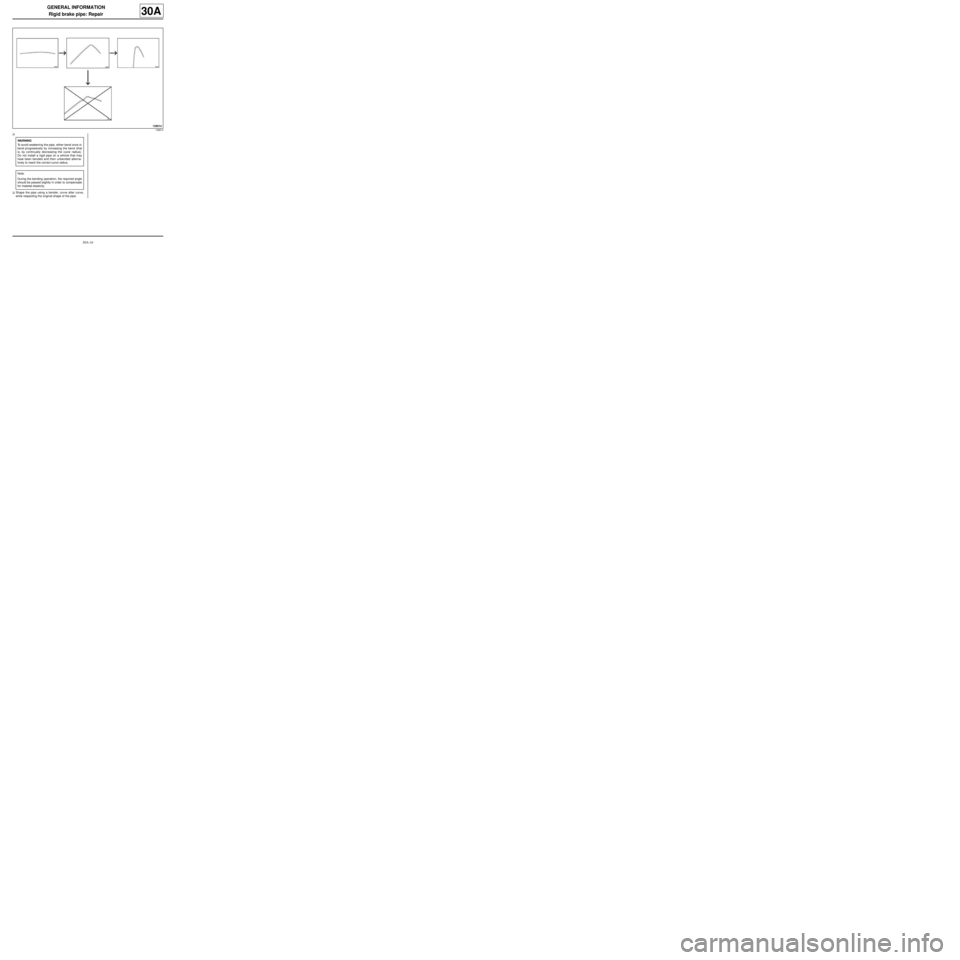
30A-16
GENERAL INFORMATION
Rigid brake pipe: Repair
30A
a
aShape the pipe using a bender, curve after curve,
while respecting the original shape of the pipe.
128814
WARNING
To avoid weakening the pipe, either bend once or
bend progressively by increasing the bend (that
is, by continually decreasing the curve radius).
Do not install a rigid pipe on a vehicle that may
have been bended and then unbended alterna-
tively to reach the correct curve radius.
Note:
During the bending operation, the required angle
should be passed slightly in order to compensate
for material elasticity.